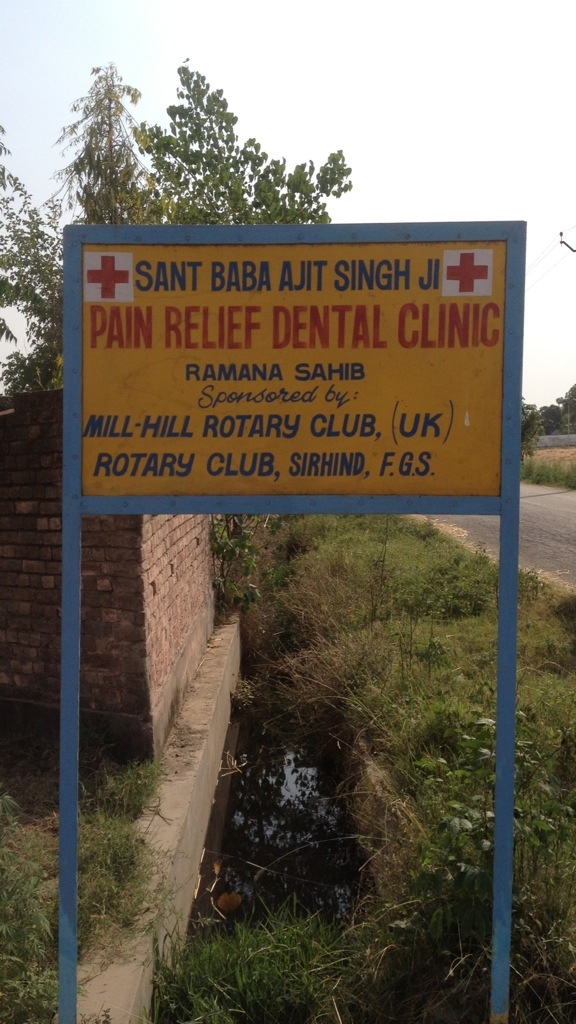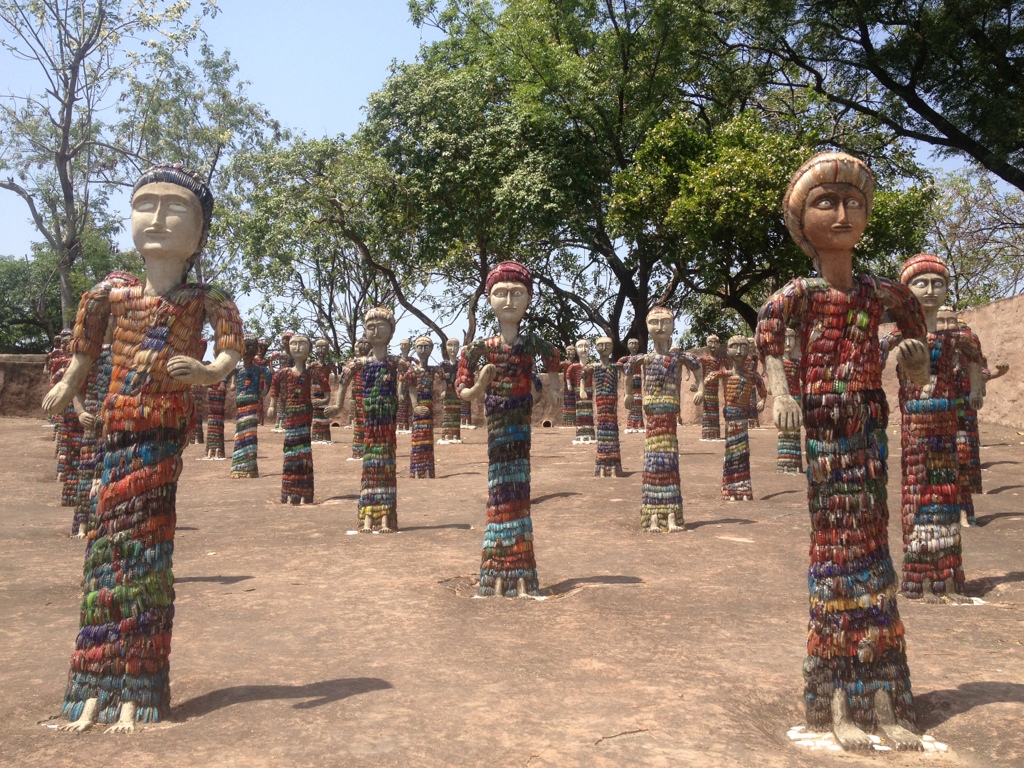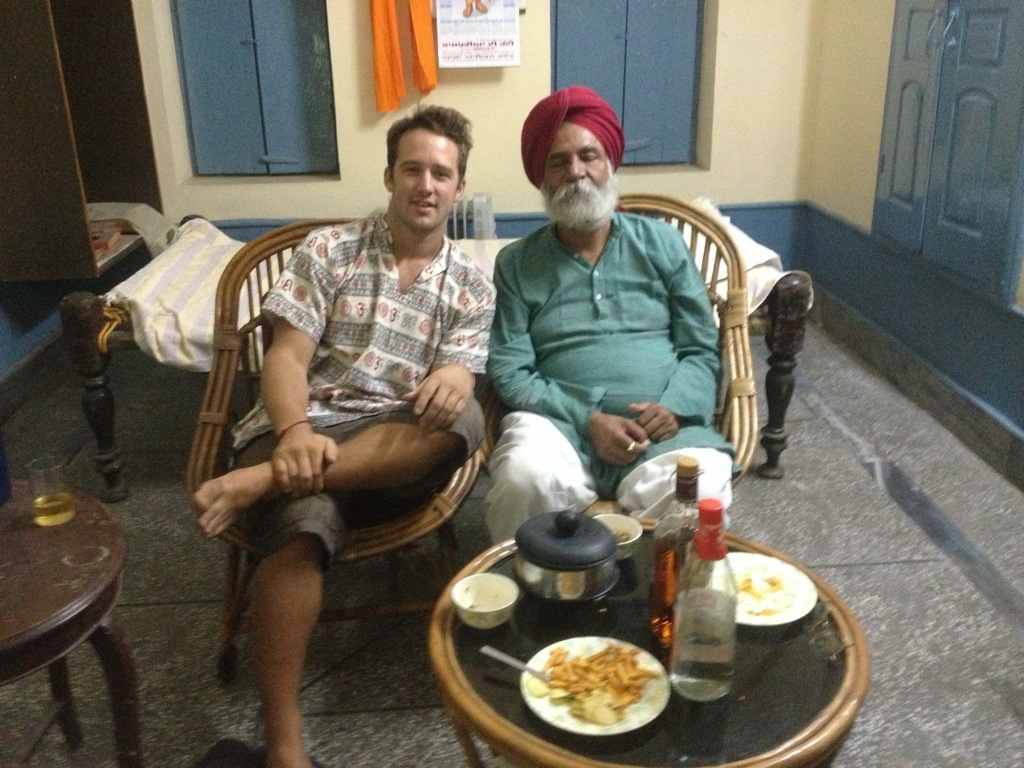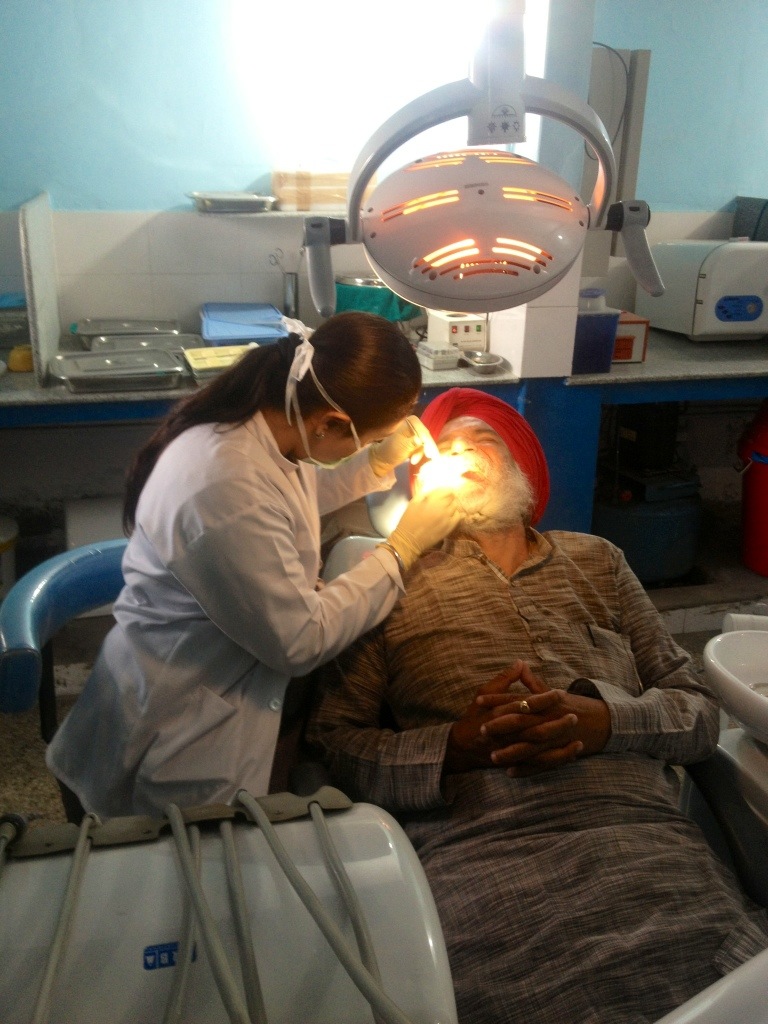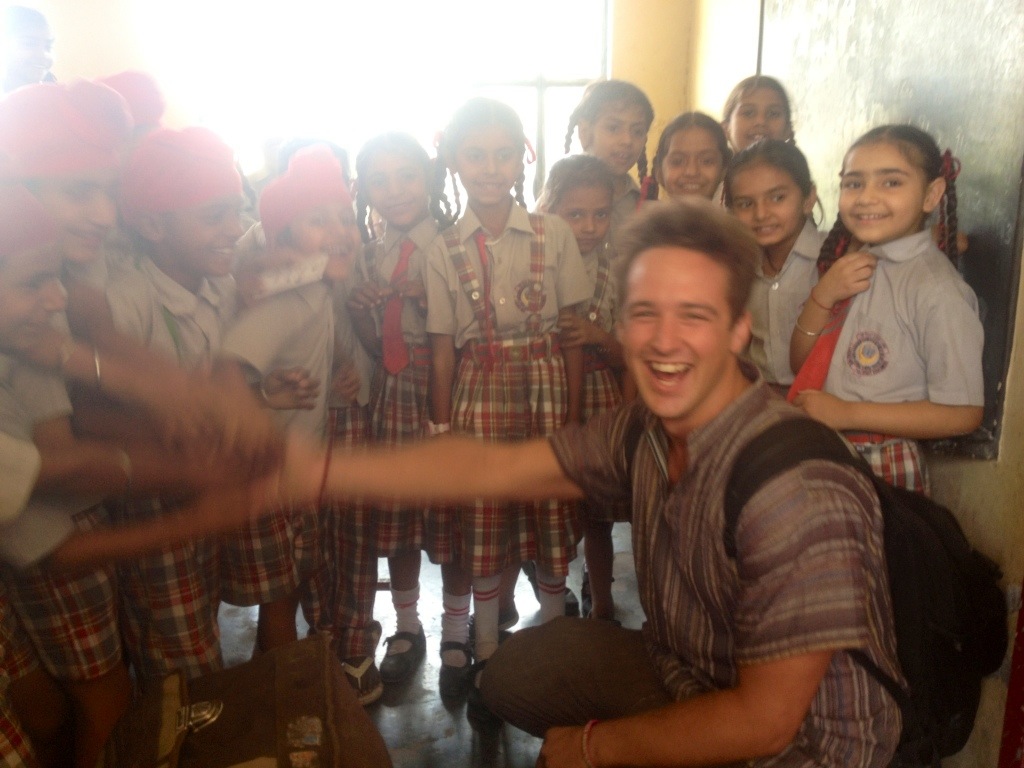Chandigarh & Dr Coonar’s Villages – Hansali & Hindupur, Punjab
Hansali is a village in rural Punjab, a northern state of India, half an hour’s drive from Chandigarh, with a population of around 200. The main, in fact only, industry in the village is agriculture. The population of Hansali spend half of the year planting, cultivating and harvesting wheat, until the rains begin in mid-June and the wheat is replaced with padi (rice).
Oddly, for a village of its size, it contains a school, a college, a gudwara (Sikh temple – one which plays host to up 20,000 worshippers on some of the major holy days, offering each and every person that visits a meal of dal, rice, roti and vegetables completely free of charge) and a dental ‘pain relief’ clinic. All of this is much to the thanks of a particular man (or ‘saint’), Babaji.
Babaji, meaning respected (-ji) wise man (baba-), resides at Hansali’s gudwara. He is said to be an enlightened man who is directly in touch with God himself but who, seemingly, does not identify with any particular religion. “God is God” I am told as I gaze around his room in the temple, the walls adorned with images of Shiva, Jesus, Guru Nanak and Islamic symbols, to name but a few. He has earned his status as a holy man as many miracles and prophecies have been performed throughout his life, starting when he was just a child and could recall people, places and specific details from his former life.
My first meeting with Babaji is on the morning I arrive in Hansali. I was taken to the gudwara by Dr Amit Handa, a dental practitioner working at the pain relief clinic, who had kindly brought be along with him from Chandigarh. I purchase a handkerchief from a stall outside the gudwara to cover my head, remove my shoes (both actions symbolic of humility in respect of Sikhism, where all people of all races, religions, castes and gender are considered absolutely equal) and enter the temple. We enter the prayer room, where the Sikh holy book, the Guru Granth Sahib, is covered in a shroud and passages are read out over loud speakers almost constantly throughout the day. Dr Handa, a Hindu, kneels before the shrine and I follow, thinking its rather odd that a Hindu and a Catholic are kneeling down to pray in a Sikh temple. We then go and get breakfast and join the other morning worshippers sitting on the floor eating, another sign of equality for all in the temple. We then go to visit Babaji, and I am led into a room where a line of people move through one door and out another (the first time I’ve seen Indians respecting the western rules of queuing!), moving past Babaji, touching his feet and making donations.
As soon as I see the rupee notes that are being collected by Babaji’s assistant my skeptical mind begins to question the entire affair. I wonder how much money he collects each day, let alone on particularly special occasions. Most of the people working in the temple I’m sure will be volunteers. Where does all this money go? My mind wander to a documentary I had seen some years back about people in America claiming to be Christian faith healers, with their mansions and helicopters. My questions and skepticism would soon be answered.
Rural India is somewhat different to the parts of India I had already come to love, just 3 weeks after landing at Mumbai’s Chhatrapati Shivaji international airport.
Mumbai was loud, brash and colourful (particularly as I’d arrived on the eve of Holi, the Hindu festival of paint throwing!), Delhi had been louder and, to some extent, the India I had been warned about, Agra, home of the Taj Mahal, was the tourist trap the guide books had said it would be, and the sleepy beaches of Goa had been welcome relaxation after a week and a half’s relentless sight-seeing. My next stop would be Chandigarh, a city planned by Swiss-French architect Le Corbusier, in the north Indian state of Punjab.
I had been invited to Chandigarh by a friend of my Grandfather’s, Dr Hardev Singh Coonar, as a brief stop before heading to his native village of Hindupur, a few kilometres from Hansali. Dr Coonar’s brother- and sister-in-law, Yash and Usha, had kindly offered to put me up for an unlimited amount of time while I visited Chandigarh and the villages, and their incredible hospitality turned the ‘brief stop’ into a four-night luxurious stay. I was doted upon, fed to bursting point and thoroughly well watered with Kingfisher beer and Old Monk rum! My first of many experiences of the famous Indian hospitality. After seeing the sights of Chandigarh (the government buildings, university, research hospital, rose garden and ‘Nick Chan’s Rock Garden’, to name but a few) in an extremely lazy fashion, and spending a fair amount of time in Yash’s golf club bar (Chandigarh golf club, which is twinned with Arkley golf club), I decided it was time to move on to the village.
The purpose of Dr Coonar’s invite was for me to experience rural India and to visit the dental clinic. Dr Coonar, a retired dentist, and his elder brother Dr Pritam Singh Coonar, who sadly passed away in October 2012, had been instrumental in setting up the village dental clinic with the help of funding from Mill Hill Rotary Club, Rotary Club Sirhind, and Babaji. Whilst Dr Coonar himself would not be in India at the time of my visit, he explained that his nephew, Dr Harpreet Singh Sandhu, was staying at the family home and would look after me while I visited.
For more information about Dr Pritam Singh Coonar and the legacy he has left for the people in this rural part of Punjab, please have a read of this article.
I was taken to the clinic from the gudwara by Dr Handa and met the staff there. There are 4 dentistry stations in the clinic, 4 dentists including Dr Handa, and a queue of 45 people waiting outside; a slightly above-average queue but just about normal for a Sunday, I am told.
Soon, Dr Sandhu arrives and I am whisked away to a local Catholic Church where a Sunday school for all ages is taking place and the children are completing a quiz on their knowledge of the book of Acts. “Easy!” I think, having completed 13 years of education in Catholic schools, and I ask for an English translation of the quiz.
Q: Of what age was the cripple, healed by Peter and John at the temple gate?
a. 28 years old
b. 35 years old
c. Over forty years old
d. 50 years old
Q. Among the seven chosen to wait on tables there was one from Antioch, a convert to Judaism. What was his name?
a. Stephen
b. Nicolas
c. Nicanor
d. Timon
Never mind that then!
By this time the midday summer sun is beating down and it’s time for lunch followed by a 5 hour siesta, something I have discovered is very popular amongst the middle class, retirees of India. Lunch is, as usual roti, rice, dal and vegetables. And is, as usual, delicious.
Once the sun begins to dip below the horizon, we venture out into the village to meet some people. People, particularly young children, are very interested to see the gora (white man) in the village, and Dr Sandhu explains to each of them in Punjabi that I’m from London (“Proper London?”) and that I’m an engineer (as I’ve grown tired of trying to explain what a ‘Quantity Surveyor’ is, even to westerners), and I receive a lot of handshakes, bows and hands on shoulders in return. Dr Sandhu and I then spend the evening practicing two of India’s most beloved pastimes; drinking whiskey and watching cricket.
The next day I visit the primary and middle school in Hindupur where the children are gathered for their Monday morning assembly. This involves a lot of singing, including the national anthem, and reciting of letters, colours, days of the week, all in Punjabi and English, and a few different songs.
I am returned to the dental clinic the next day and explained in a bit more detail how it all works. Dr Coonar’s family, currently represented by Dr Sandhu, run the clinic from a management point of view. It is funded, as mentioned previously by a number of bodies and also in the form of voluntary donations by anybody who receives treatment at the clinic. On an average day the clinic will see between 30 and 40 patients, but it is not unknown for upwards of 60 patients to turn up. Hard work for a team of only 4 dentists in an area where dental hygiene is placed low on the list of priorities for families that, in general, live below the poverty line.
But the dentists seem to love their work. The passion that people have for one another in India is outstanding.
Once the clinic has seen all the patients, at about 1:30, a particularly quiet day, we walk back up to the gudwara for lunch, with a quick stop at another Babaji project on the way; the school.
Hansali school takes students from class 1 through to class 12, with double form entry in each year: a capacity of almost 1000 students. Buses are provided, delivering children to and from other villages in the region. On the walls of the courtyard are displayed enigmatic slogans in Punjabi and English, the daily reading from the Sikh holy book is written on a chalk board, the top 5 daily newspaper headlines on another. The head teacher kindly offers to show me around from the youngest classes to the oldest, and I experience a Dulux colour chart of reactions: from silent bewilderment, through screaming excitement, all the way to nonchalant ambivalence.
After another free meal at the gudwara, I am granted a private audience with Babaji and I am given the opportunity to ask questions of his assistant, who has devoted his life to Babaji and lives with him in the temple, but had once been a marine engineer in the Indian navy, and speaks fluent English. I am told the story of how Babaji came to be Babaji and I ask about the money.
The money, in its entirety, goes toward the supply of food in the gudwara; food that never runs short, even on the days when 20,000 pilgrims visit, and for the running and upkeep of what is, in all honesty, a fairly modest temple. This of course includes some required to keep Babaji, his assistant and various other full time workers in the temple going, although they all devote their lives there and essentially take a vow of poverty.
The remainder of the donations, I am told, are donated, in their entirety, to community projects. The dental clinic. The school. A wedding for a village family that cannot afford one. Transport for people who cannot get around otherwise. I am also told that if supplies are donated, such as a bar of soap for instance, it is recorded in detail when it is used and how long it lasts to ensure that nothing untoward is happening with donations.
I am given a gift as I leave; a large orange cloth, a symbol of spirituality, and a bag of “holy food”, blessed almonds. I am never asked for any kind of donation, nor do I feel that one is expected from me, a strange feeling having spent a month in India, and it makes me feel more inclined to give one.
I read a worrying thing in the Times of India that weekend, following the Boston bombings. A Sikh leader in America had made a statement, as a matter of course when these things occur, as an attempt to divert suspicion from American Sikhs. I read that Sikh men are often targeted in the fallout of these incidents due to their “conspicuous appearance” of a kesha (uncut beard and hair) and turban.
So far in my experience of India, a country which seems to be based upon basic principles of love and respect for one another, Sikh’s have been the most hospitable, friendly and kind that I have met. The founding principle of Sikhism, that all men, women and children are equal, is something we could all learn a lot from and do well to follow in our own lives. If only people in the west were more educated when it comes to these types of traditions and religions, I think the world (and the west, in particular) would be a more welcoming and accepting place for everybody. The fact that some uneducated westerners will mindlessly single out a man wearing a turban and connect them with terrorism without any evidence is shocking and saddening.
Dr Handa and I decide to head back to Chandigarh and Babaji’s assistant offers to provide a driver to drop us home, which we gratefully accept.
I am treated to one more night with Uncle Yash and Auntie Usha before I depart for Amritsar, the home of the Golden Temple, in the morning.
I am about to see the real beauty of Sikhism. So far, the surface has only been scratched.
Posted from .
